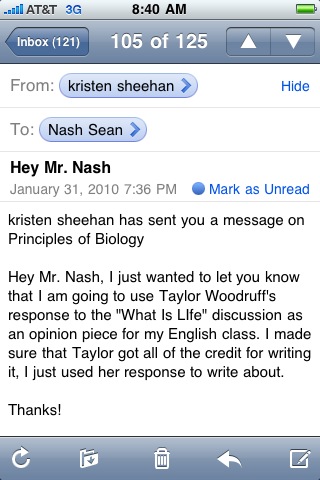Connected
An interesting thing happened on the way home from Educon 2.2 last Sunday night. Walking through the terminal and against my exhaustion, I reflexively checked my mail. Lazy eyes lifted open, I flicked my thumb scrolling… trolling for a demand of action. I’m hyper-connected. I pay for it. And yet, I’m a better teacher and leader because of it. Cutting to the chase, here is the simple, yet interesting email I received:

Background
Here are the things you must know/appreciate/love about the aforementioned interaction…
- Principles of Biology is the learning network we continue to create within our class on the Ning platform. Begun only last year, I believe it really is a solid example of open student discourse in a core content area.
- Kristen Sheehan is no longer a student at Benton High School. Although she has graduated and moved on to the University world… she remains a member of our network.
- Taylor Woodruff is a Senior, and a current member of our network.
- “What is Life?” was a rather intense classroom discussion back near the beginning of this school year that continued in our online space.
- Kristen courteously informs and carefully cites the original work.
Here is one explicit snippet providing a specific example of continued value added to the lives of our students. Here, a former student used a current student’s online reflection as an opinion-based piece in her current English studies at the university level. That is a pretty obvious sign that work done in this educational network is of continued value beyond the initial grade earned for the work. If that isn’t an indicator of the continued educational value of a network then I don’t know what is.
It’s certainly not the first time we have collected evidence of this kind from our work done online. In this network, as well as our Marine Biology network (implemented rather differently), former students often stop in to add something significant they run across in their lives after our time together in the classroom. This might be to share an interesting experience, reflection, testimonial, news story, image, video, or webpage. It might be to share good fortune, changes or advances in educational plans, or to announce landing a new job. Or perhaps you’re just planning to live-blog the hurricane that smashed your campus- causing you to live inland in Texas to finish out the year. And really, these are just the public communications. Many folks are more shy about their comings and goings after school, and send only direct messages… and this of course is very cool as well.

Challenge
I always wonder how often these former students just browse on in to do some version of a “virtual walkthrough” to see what sorts of new things are shaking in an environment they were once part of. I wonder if those that do so actually realize that they too are still an element of our learning environment? I wonder how I can further facilitate what is already happening organically as a result of these networks.
I try to remind myself to see examples like this one as starting points to build upon… as opposed to merely “evidence of prior good.” Thoughts?
Artwork
*”PhotonQ-Woman ‘s Thoughts aKa Complex Memetics” by PhOtOnQuAnTiQuE on Flickr *My personal iPhone screenshot. You know it’s art. Come on….
I always enjoy when prior students drop me a note about their current lives or learning. I think using a network like Ning makes it much easier for them to drop by & share. How do you take this to the next level? Ideally, I (and I think you) would like our ex-students to continue to participate in these networks.
Do you actively encourage ex-students to contribute? I’m just starting to use Ning and have been thinking about the role I’d like ex-students to play: How can I encourage their continued participation without coercion? Perhaps inviting ex-students to comment and assess current students? Asking current students to contact ex-students for extra help?
I’m optimistic ex-students can be valuable resources, though I’m not sure if there’s a good way to encourage their increased participation beyond providing spaces where the organic sharing, teaching, and learning can easily happen.
Great questions, Ben (sorry so late getting back).
I am beginning to see former (?) students voluntarily return to these spaces to interact in a collaborative way. It is that autopilot threshold that is so hard to tip over. Once that happens, you have built a true community of practice, and not just a captive audience.
That said, I do toss back subtle reminders from time to time. For example, a former student and PhD candidate in Marine Biology/Marine Policy recently co-authored an amazing work that she sent to me via email. She has often written back to our network in the past to keep people up to date with her goings-on. When I got the paper via email, my reply included something like: “if you get a few minutes here in the next few weeks, consider dropping that on the blog with a bit of summary to make it palatable to the current students.”
Think about it. Good people are so often just a reminder away from doing good things. I think this is far far from coercion. Gentle nudges and suggestions do not make the growth of a network “inorganic” in my opinion. Think about the times when you have bent over backward to help a friend or colleague after a subtle reminder where you’ve said something to the effect of: “Oh gosh- of COURSE. Feel free to ask for that ANYtime.”